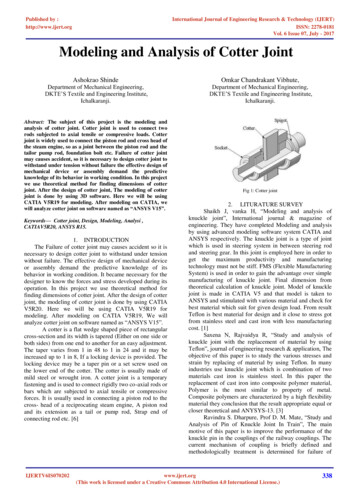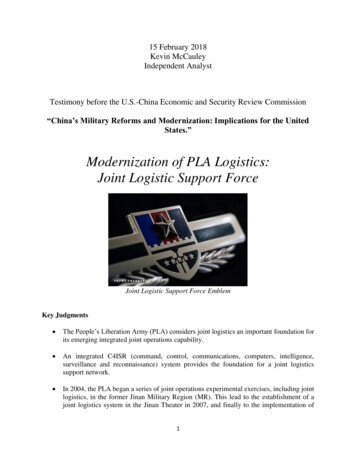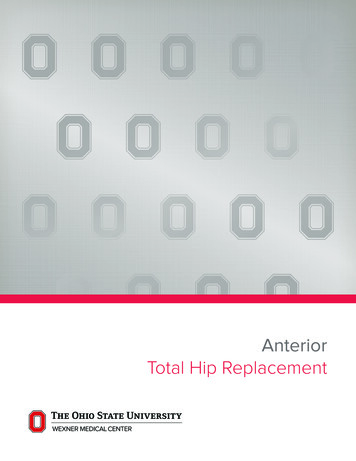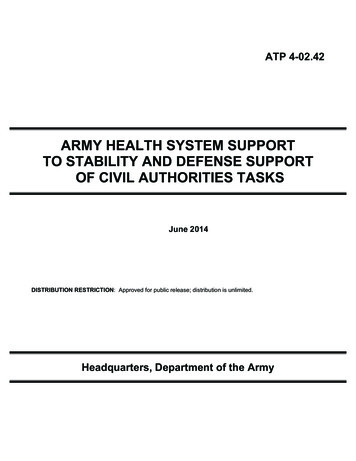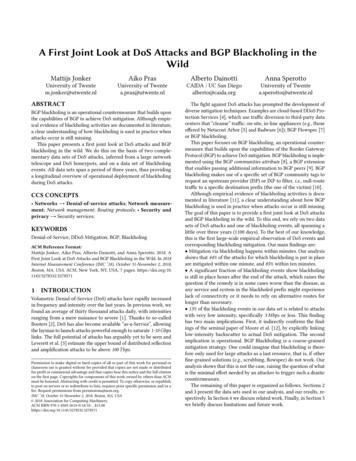
Transcription
A First Joint Look at DoS Atacks and BGP Blackholing in theWildMattijs JonkerUniversity of Twentem.jonker@utwente.nlAiko PrasUniversity of Twentea.pras@utwente.nlABSTRACTBGP blackholing is an operational countermeasure that builds uponthe capabilities of BGP to achieve DoS mitigation. Although empirical evidence of blackholing activities are documented in literature,a clear understanding of how blackholing is used in practice whenattacks occur is still missing.This paper presents a frst joint look at DoS attacks and BGPblackholing in the wild. We do this on the basis of two complementary data sets of DoS attacks, inferred from a large networktelescope and DoS honeypots, and on a data set of blackholingevents. All data sets span a period of three years, thus providinga longitudinal overview of operational deployment of blackholingduring DoS attacks.CCS CONCEPTS Networks Denial-of-service attacks; Network measurement; Network management; Routing protocols; Security andprivacy Security services;KEYWORDSDenial-of-Service; DDoS Mitigation; BGP; BlackholingACM Reference Format:Mattijs Jonker, Aiko Pras, Alberto Dainotti, and Anna Sperotto. 2018. AFirst Joint Look at DoS Attacks and BGP Blackholing in the Wild. In 2018Internet Measurement Conference (IMC ’18), October 31-November 2, 2018,Boston, MA, USA. ACM, New York, NY, USA, 7 pages. ONVolumetric Denial-of-Service (DoS) attacks have rapidly increasedin frequency and intensity over the last years. In previous work, wefound an average of thirty thousand attacks daily, with intensitiesranging from a mere nuisance to severe [1]. Thanks to so-calledBooters [2], DoS has also become available “as-a-Service”, allowingthe layman to launch attacks powerful enough to saturate 1-10 Gbpslinks. The full potential of attacks has arguably yet to be seen andLeverett et al. [3] estimate the upper bound of distributed refectionand amplifcation attacks to be above 100 Tbps.Permission to make digital or hard copies of all or part of this work for personal orclassroom use is granted without fee provided that copies are not made or distributedfor proft or commercial advantage and that copies bear this notice and the full citationon the frst page. Copyrights for components of this work owned by others than ACMmust be honored. Abstracting with credit is permitted. To copy otherwise, or republish,to post on servers or to redistribute to lists, requires prior specifc permission and/or afee. Request permissions from permissions@acm.org.IMC ’18, October 31-November 2, 2018, Boston, MA, USA 2018 Association for Computing Machinery.ACM ISBN 978-1-4503-5619-0/18/10. . . o DainottiCAIDA / UC San Diegoalberto@caida.orgAnna SperottoUniversity of Twentea.sperotto@utwente.nlThe fght against DoS attacks has prompted the development ofdiverse mitigation techniques. Examples are cloud-based DDoS Protection Services [4], which use trafc diversion to third-party datacenters that “cleanse” trafc; on-site, in-line appliances (e.g., thoseofered by Netscout Arbor [5] and Radware [6]); BGP Flowspec [7]or BGP blackholing.This paper focuses on BGP blackholing, an operational countermeasure that builds upon the capabilities of the Border GatewayProtocol (BGP) to achieve DoS mitigation. BGP blackholing is implemented using the BGP communities attribute [8], a BGP extensionthat enables passing additional information to BGP peers [9]. BGPblackholing makes use of a specifc set of BGP community tags torequest an upstream provider (ISP) or IXP to flter, i.e., null-routetrafc to a specifc destination prefx (the one of the victim) [10].Although empirical evidence of blackholing activities is documented in literature [11], a clear understanding about how BGPblackholing is used in practice when attacks occur is still missing.The goal of this paper is to provide a frst joint look at DoS attacksand BGP blackholing in the wild. To this end, we rely on two datasets of DoS attacks and one of blackholing events, all spanning alittle over three years (1100 days). To the best of our knowledge,this is the frst large-scale empirical observation of DoS events andcorresponding blackholing mitigation. Our main fndings are: Mitigation via blackholing happens within minutes. Our analysisshows that 44% of the attacks for which blackholing is put in placeare mitigated within one minute, and 85% within ten minutes. A signifcant fraction of blackholing events show blackholingis still in place hours after the end of the attack, which raises thequestion if the remedy is in some cases worse than the disease, asany service and system in the blackholed prefx might experiencelack of connectivity or it needs to rely on alternative routes forlonger than necessary. 13% of the blackholing events in our data set is related to attackswith very low intensity, specifcally 3 Mbps or less. This fndinghas two main implications. First, it indirectly confrms the fndings of the seminal paper of Moore et al. [12], by explicitly linkinglow-intensity backscatter to actual DoS mitigation. The secondimplication is operational. BGP Blackholing is a coarse-grainedmitigation strategy. One could imagine that blackholing is therefore only used for large attacks as a last resource, that is, if otherfne-grained solutions (e.g., scrubbing, fowspec) do not work. Ouranalysis shows that this is not the case, raising the question of whatis the minimal efort needed by an attacker to trigger such a drasticcountermeasure.The remaining of this paper is organized as follows. Sections 2and 3 present the data sets used in our analysis, and our results, respectively. In Section 4 we discuss related work. Finally, in Section 5we briefy discuss limitations and future work.
IMC ’18, October 31-November 2, 2018, Boston, MA, USAsource#events #targets #ASNsUCSD-NT 15.89 M 2.94 M 29750AmpPot 12.25 M 6.03 M 28425Combined 28.14 M 8.58 M 36939Joint447.6 k 0.18 M9218Table 1: Denial-of-Service data from UCSD-NT and AmpPotfor March 1, 2015 – March 5, 2018. We fnd 28.14 M attacks,targeting 8.58 M unique IP addresses.2DATA SETSIn this paper, we consider two DoS attack events data sets and onedata set of BGP blackholing events. All data sets cover the sameperiod, from March 1, 2015 through March 5, 2018.2.1DoS Attack EventsThe DoS data sets contain various attack types, measured by established and complementary data sources.Randomly and Uniformly Spoofed Attacks – The frst data seton DoS attacks is inferred from backscatter packets that reach theUCSD Network Telescope [13] (UCSD-NT). The UCSD-NT is alargely-unused but routed /8 network operated by University ofCalifornia, San Diego. It passively collects unsolicited trafc resulting from, among others, scans, misconfgurations, and backscatter from Denial-of-Service attacks. The UCSD-NT covers approximately 1/256 of the IPv4 address space. This means that a randomlyand uniformly selected IPv4 address has an approximate probabilityof 1/256 to fall within UCSD-NT’s address space. Randomly anduniformly spoofed attacks are often visible at the UCSD-NT as theseattacks typically involve backscatter to a substantial number [1, 12]of spoofed IPv4 addresses. To infer attacks we use the classifcationmethodology described by Moore et al. [12]. For each attack weregister, among others: the attack’s target, i.e., intended victim –apparent from the backscatter packets; the attack’s (observed) beginning and end times; and a measure of attack intensity based onbackscatter packet rate.1 Further details on the implementation canbe found in Jonker et al. [1].Refection and Amplifcation Attacks – The second data set onDoS attacks is inferred in honeypots running AmpPot [14]. In refection and amplifcation attacks, requests with a specifcally spoofedsource address are used to trigger refectors to send unrequestedresponse packets. The address is set to be that of the intended victim and the responses are typically considerably larger than therequests (i.e., there is amplifcation). AmpPot emulates various protocols known to be abused in this type of attack, such as NTP, DNSand CharGen [15]. During an attack, the attacker sends requests –apparently coming from the intended victim – to AmpPot. AmpPot records these requests and registers various information abouteach attack, such as: the target – apparent from the source addressspoofed in the requests; a measure of attack intensity based on therequest rate; and the attack’s (observed) beginning and end times.We use data from 24 AmpPot instances.2 It has been shown that thisnumber of AmpPot instances is sufcient to register most refection1 Asnot all attack trafc leads to backscatter, this intensity forms a lower bound.US houses 11 instances, 8 are in Europe, 4 are in Asia and 1 is in Australia.2 TheMatijs Jonker et al.collectors #events #prefxes #origins #AS paths34 1.30 M146193268231493Table 2: Blackholing data set inferred from public BGP datafor March 1, 2015 – March 5, 2018. We infer 1.3 M blackholing events, involving 146193 prefxes.attacks on the Internet. Further details on AmpPot can be found inKrämer et al. [14].The UCSD-NT data set includes spoofng attacks that directlytarget the victim. The AmpPot data set, diferently, reports on indirect (refected) attacks. As such, the two data sets complementeach other. The data sets, however, do not cover attacks in whichpackets are sent without any form of source IP address spoofng.Table 1 summarizes the data sets in terms of attack events, targetsand involved ASNs.2.2Blackholing EventsWe obtain a data set of inferred blackholing events from publiclyavailable BGP routing data, using a measurement system that weimplemented on the basis of the methodology described by Giotsaset al. [11].Public BGP data – We use data from two projects that ofer publicBGP data: (1) University of Oregon’s RouteViews Project (RV) [16];and (2) RIPE NCC’s Routing Information Service (RIS) [17]. Boththese projects gather Internet routing data from globally dispersedcollectors that peer with one or multiple routers.3Blackholing Communities – Within the BGP data, we look for BGPannouncements tagged with a community that is likely to signal ablackholing request. Giotsas et al. [11] created a dictionary of suchcommunities by applying natural language processing to resourceswhere blackholing communities are likely to be documented (e.g.,in Internet Routing Registry (IRR) records). We use a copy of thisdictionary, which provides us with 288 asn:value community tags,for 251 blackholing providers, using 74 distinct values (e.g., 666). 4Inferring Blackholing Events – We implemented a measurementsystem in Python that utilizes pyBGPStream, a Python interface tothe BGPStream framework for BGP data analysis [18]. Because ofour focus, we do not consider prefxes less specifc than a /24, sincethese are not commonly blackholed [11, 19]. We do infer blackholing activity incrementally, by analyzing BGP updates, and do notparse a full RIB dump at the beginning of the observation period.5To create our data set, we analyze data from 36 BGP collectors.6Each event in the data set contains, most notably: the blackholedprefx, a start time (i.e., activation time), an optional end time (i.e.,deactivation time), a list of collectors on which prefx-related activity was observed7 , and the matched communities.3 Packet Clearing House also provides public BGP data; we do not use these, primarily due to lack of support in the BGPStream framework.4 The dictionary contains the majority of BGP blackholing communities, but it isnot necessarily complete due to methodological limitations [11].5 Consequentially, we will miss blackholing events that started before March 2015.6 Not all blackholing announcements propagate as far as public BGP collectors,meaning that we cannot possibly infer all blackholing events [11].7 Blackholing activity is considered related if it (partially) overlaps in time. Anevent’s activation and deactivation are set to the minimum and maximum BGP record
A First Joint Look at DoS Atacks and BGP Blackholing in the WildTable 2 summarizes our data set. 34 of the 36 collectors we consider see at least one blackholing event in the measurement period.8The majority of blackholing events are deactivated (strictly) throughprefx withdrawal as opposed to through a re-announcement without a blackholing community tag. Specifcally, we witness 1.294 Mwithdrawals, against 1.7 k re-announcements. Roughly 1.6 k (0.12%)of events are open-ended, i.e., are still active on the last day of ourmeasurement period. We also fnd 6 k events that are deactivatedboth through withdrawal and re-announcement.93BLACKHOLED 6h3h2h1hm30m15m105m1ms30s15s10timestamps encountered in BGP announcements and withdrawals. A blackholing eventcan be activated through a prefx announcement with a blackholing community set,and deactivated either through re-announcement without a blackholing communityset, or through a prefx withdrawal. We presume consistent propagation characteristicsbetween announcements and withdrawals.8 The 2 collectors that did not provide us with any blackholing events are RV’sKIXP and NAPAfrica. The latter was added in February 2018 and thus only overlapswith our observation period for about a month. In fact, RIPE NCC’s RIS and RouteViewsknow a total of 43 collectors combined at current. BGPStream indexed 41 of them whilewe ran our analysis, of which we considered only 36 as 4 were not active during thestudied period (rrc02, rrc06, rrc08 and rrc09), and 1 is IPv6 only (route-views6).9 This can occur if the event is inferred from BGP events on multiple collectors.10 We will show that blackholing is often triggered well within the hour followingan attack’s start time.Interestingly, for the 447.6 k attacks jointly launched against thesame target (Table 1) that we observe in our DoS data sets, we fnd18.4 k (4.12%) to be blackholed. This involves 3.25% (5.7 k) of uniquetarget IPs, which, compared to 0.81%, leads us to believe that moreserious attacks (i.e., those in which we observe the combination ofmultiple attack types) are more likely to be blackholed.Our comparison of data sets also allows us to shed some light, forthe frst time, on the popularity of randomly-spoofed and refectionattacks compared to other DoS attacks (e.g., unspoofed) for whichso far the research community has not been able to provide dataon a global scale [1]. Table 4 shows we fnd 159.9 k blackholingevents preceded by a randomly spoofed attack, and 306.4 k preceded by a refection attack. This means that we match 27.8% ofall 1.30 M (Table 2) blackholing events in our data set with attacks.While, this preliminary result does not allow us to infer the fraction of diferent categories of attacks, it highlights that togetherrandomly-spoofed and refection attacks represent a signifcant share of the attacks that operators dealt with in the lastthree years.5sWe analyze our data sets on attacks and blackholing to fnd “blackholed attacks”. In this analysis, we require an attack’s target IPaddress to be covered by a blackholing event’s prefx, and the attack’s start time to precede the blackholing event’s activation intime (of at most 24 hours).10Table 3 summarizes the matches. Surprisingly, we fnd morethan 450 k attacks, towards almost 70 k targets (and involving 2.5 kASNs) that were mitigated through blackholing. This is the frstlarge-scale empirical observation of DoS events and corresponding blackholing mitigation.Only small percentages of the UCSD-NT and AmpPot data setsare blackholed, i.e., 1.35% and 1.97% of attacks, and 1.17% and 0.79%of unique targets. (Combined, we see blackholing for 0.81% of allunique target IPs.) While at frst look these small percentages mightsuggest that the data sets we examined contain “noise” (i.e., inferredattacks of negligible intensity), we show later in this section thateven small intensities trigger blackholing. We thus conclude thatsuch percentages refect that (i) we can observe blackholing onlyfor a subset of ASes/targets and (ii) its adoption, while signifcant(2543 ASNs observed), might not be largely widespread. As futurework we plan to further investigate this aspect, combining our datawith blackholing at IXPs and the visibility of other community tags.attack source #blackholing events#prefxesUCSD-NT159.9 k (12.3%) 20.6 k (14.1%)AmpPot306.4 k (23.5%) 33.5 k (23.0%)Combined363.0 k (27.8%) 45.2 k (30.9%)Table 4: Blackholing events that follow an (observed) Denialof-Service attack in the UCSD-NT or AmpPot data sets, aswell as for attacks in either. We match 363.0 k of 1.30 Mblackholing events with attacks (27.8%).Percentage of attackssource#attack events#targets#ASNsUCSD-NT 214.9 k (1.35%) 34.5 k (1.17%)1732AmpPot 241.0 k (1.97%) 47.5 k (0.79%)2197Combined 456.0 k (1.62%) 69.7 k (0.81%)2543Joint18.4 k (4.12%) 5.7 k (3.25%)800Table 3: Blackholed Denial-of-Service attacks. This is thefrst large-scale empirical observation of DoS events and corresponding blackholing mitigation: 456 k of the 28.16 M attack events in our data sets are blackholed (1.62%), whichinvolves 0.81% of all uniquely targeted IP addresses.IMC ’18, October 31-November 2, 2018, Boston, MA, USATime until blackholingFigure 1: Time until blackholing is activated. The distribution of the time between the start of attacks and the start ofblackholing, for attacks in the UCSD-NT and AmpPot datasets. Almost half of all blackholed attacks (44.4%) see blackholing activated within a minute.More than half of all blackholed attacks see mitigation activated within a matter of minutes. Figure 1 shows the time ittakes for blackholing to be activated. For any blackholed attackin the data sets, we analyze the delay between the start of the attack and the start of the associated blackholing event.11 For joint11 BGP collectors, AmpPot instances, and the UCSD-NT infrastructure synchronizetime through NTP. Notwithstanding, BGP timestamps are based on when the collectorreceives an update – not when the origin AS requested blackholing. Moreover, marginaltime deviations may occur depending on where the BGP collector is in relation to theblackholing provider.
Matijs Jonker et al.Percentage of attacksblackholed attacks – which may not see the randomly spoofed andthe refection attack start at the same time – we assume that theattack component that had started earlier in time triggered theblackholing event. To account for this assumption, we pick thelonger mitigation delay for our analysis.12,13 Nearly half of blackholed attacks (44.4%) see the blackhole activated within one minute,and 84.2% see activation within ten minutes. Such times suggestthe use of automated detection and mitigation. Only for 0.02% ofblackholed attacks it takes longer than six hours for blackholing tobe hh24m126h3h1h30m105m1ms305s1sAttack end until blackhole deactivationFigure 2: The distribution of the time between the end ofattacks in the AmpPot data set, and the end of correlatedblackholing events. In 74.8% of blackholed refection attacks,the blackholing is withdrawn in three hours or less after theattack stopped. In some cases, however, blackholing is leftactive for days after.Often blackholing mitigation lasts way beyond the attackduration. Figure 2 shows the time between the end of blackholedattacks in the AmpPot data set and the end, i.e., deactivation time,of the associated blackholing event.14 We show that for 74.8% ofblackholed attacks the blackhole is deactivated within three hoursafter the end of the attack. 96.1% of blackholed attacks see deactivation within 24 hours, meaning that for 3.9% it may take multipledays. These results suggest lack of automation in recovery fromblackholing, and highlight that its side-efects (completely blocking any trafc reaching the victim) extend beyond the duration ofthe attack, i.e., a sort of self-inficted DoS. Later in this section weprovide some results about the potential impact of blackholing ondiferent type of infrastructure.We see evidence that less intense attacks are also mitigated.The UCSD-NT data set contains a measure of attack intensity(ppsmax ), expressed in terms of the maximum number of backscatter packets per second observed. Figure 3 shows the overall distribution of intensities in the UCSD-NT data set, as well as for blackholed attacks only. 64.6% of blackholed attacks (gray curve) have12 In doing so we favor the risk of introducing “longer-than-actual” over “shorterthan-actual” times when estimating the delay with which blackholing starts. In otherwords, we pick an upper bound for the mitigation delay. It should be noted that wecan only do this for joint attacks that we recognize as such, meaning that we cannotaccount for attack components that we do not observe (Section 2.1). However, basedon our observations of randomly spoofed attacks and refection attacks, joint attacksare relatively rare.13 We analyzed the start time diferences between attack components of the 18.4 kjoint blackholed attacks in our data (Table 3) and fnd that 85.54% see the attack startspaced less than 40 minutes apart.14 Blackholing “truncates” the attack end times in UCSD-NT data, which is whywe do not analyze deactivation delays for randomly spoofed attacks.Percentage of attacksIMC ’18, October 31-November 2, 2018, Boston, MA, allBlackholed13.1%110100100010kNumber of packets per second (max)100kFigure 3: The intensity distribution for all attacks in theUCSD-NT data set (black curve), as well as for those that areblackholed (gray curve). We show that less intense randomlyspoofed attacks are also mitigated – 13.1% see an inferred intensity of at most 3 Mbps (1 packet/s observed).an intensity not greater than 100 ppsmax , which corresponds to anapproximate attack trafc volume of 300 Mbps.15 This applies to91.1% of all attacks (black curve), which confrms the intuition thatattacks for which mitigation is observed are likely to be stronger.16More importantly, a non-negligible percentage of blackholed attacks have low intensity. Specifcally, 13.1% see an intensity of atmost 1 ppsmax (3 Mbps). First, this result shows that operators mitigate – with such an extreme measure as blackholing – even lessintense randomly spoofed attacks; which raises the question ofwhat is the minimal efort needed by an attacker in order to inducethe victim to recur to “shut down” an IP address for a certain periodof time. In addition, this is the frst time we are able to confrm(on a large scale) that even the smallest attack intensities inferredthrough a methodology based on indirect and partial observation ofDoS phenomena but largely used in literature (Moore et al. [12]) arerelevant, since they trigger mitigation. Finally, this result underpinsthe validity of the surprisingly large number of DoS attacks wediscovered in a recent work [1], contributing to the bigger picture,and it provides a reference threshold to be used in the context ofmonitoring and situational awareness.The analysis of blackholed refection attacks yields similar results. The AmpPot data set contains an intensity measure (rpsavд ),expressed in terms of the average number of requests per second,e.g., DNS queries.17 The top fve refector protocols in the AmpPotdata are: (1) NTP – 40.7%, (2) DNS – 25.6%, (3) CharGen – 22.6%, (4)SSDP – 8.3%, and (5) RIPv1 – 2.6%. We consider only these protocols and note that they are used in all but 0.2% of AmpPot attacks.Figure 4 shows the intensity per protocol for the top fve refectionattack protocols for all AmpPot attacks as well as for those that areblackholed ((1) NTP – 45.0%, (2) DNS – 33.9%, (3) CharGen – 11.2%,(4) SSDP – 7.5%, and (5) RIPv1 – 2.1%). We here too show that operators also mitigate less intense refection attacks (e.g., 4.9 rpsavд forfewer for 50% of blackholed SSDP-based refection attacks). We alsoconfrm the intuition that mitigated attacks are likely to be stronger15 We assume 1500-byte packets and account for UCSD-NT’s 1/256 address spacecoverage, i.e., observing 1 backscatter packet for every 256 uniformly spoofed packets.16 In previous work we showed that stronger attacks lead to quicker outsourcingto DDoS Protection Services – another form of mitigation [1].17 AmpPot honeypots are part of a larger set of amplifers. The attack intensitydepends on all amplifers involved, and honeypots cannot know the extent of involvement. By a best-efort guess, the number of amplifers will not vary signifcantly amongattacks for the same refection protocol [1]. We thus consider the intensity per protocol.
A First Joint Look at DoS Atacks and BGP Blackholing in the WildDNSPercentage of The blackholing communities we observe refect actual traffc fltering. Figure 5 shows the duration distributions of all attacksand of blackholed attacks, for the AmpPot data as well as the UCSDNT data. For refection attacks (upper plot), the duration of attacksgoes up for those for which we observe blackholing, with 41.6% ofblackholed attacks lasting ten minutes or longer, against 29.2% forall attacks. This confrms the intuition that mitigated attacks aremore substantial also in terms of duration. For randomly spoofedattacks, however, 64.5% of blackholed attacks last ten minutes orshorter, against 55.5% of all attacks (lower plot). The duration thusdecreases. This might seem counter-intuitive at frst, but we notethat an efective blackhole will drop all target-destined trafc, including the packets that trigger backscatter. Consequentially, theattack end time observed through backscatter may not refect theUCSD-NT6hon average. Specifcally, between all AmpPot attacks and thoseblackholed, the median rates for SSDP, DNS and CharGen increasewith 0.8, 6.6 and 11.5 rpsavд respectively. RIPv1 and NTP refectionsee stronger increases, by 55.5 and 329.9 rpsavд , respectively.Given that attacks of various intensities can be launched jointlyagainst the same target, one could hypothesize that a less intenseattack will only be mitigated by a target – with such an extrememeasure as blackholing – if it is joined by a high-intensity attack.We analyzed the intensity components in the 18.4 k joint blackholed attacks in our data (Table 3). 9.82% of the joint randomlyspoofed attacks have an intensity in the 25-th percentile (whichcorresponds to an intensity of up to 2.55 ppsmax ). About a ffth ofthese attacks, 20.54%, were joined with a refection attack that fallsin the 12.5-th percentile of its respective, i.e., protocol-specifc intensity distribution (e.g., up to 13.2 rpsavд for NTP). 40.71%, 68.39% and86.79% of the aforementioned randomly spoofed attacks were joinedwith refection attacks that have an intensity in, respectively, the25-th, 50-th or 75-th percentile. The presence of low-intensity combinations in joint blackholed attacks corroborates that less intenseattacks are also mitigated with blackholing.55.5%3h2hFigure 4: For the fve most-used refector protocols, the intensity distribution of all attacks in the AmpPot data set(upper plot), as well as for those that are blackholed (lowerplot). We show that less intense refection attacks are alsomitigated. For example, 50% of all blackholed SSDP-basedattacks see at most 4.9 101001000Number of requests per second 0%90%80%70%60%50%40%30%20%10%0%Percentage of 0%80%70%60%50%40%30%20%10%0%IMC ’18, October 31-November 2, 2018, Boston, MA, USADuration of attackFigure 5: the attack duration distributions for all attacks(black curves) and blackholed attacks (gray curves) in theamppot data (upper plot) and the ucsd-nt data (lower plot).we fnd that for randomly spoofed attacks, the average duration drops, which, given the attack-inferrence methodology,is indicative that blackholing is efectively stopping (at leastpart) of victim-destined trafc.start#days2015-03-01 1100type#names #IPsWeb228.1 M 33.5 MMail (MX) 38.76 M 4.73 M2017-01-22 407DNS (NS) 7.62 M 1.54 MTable 5: Active DNS measurement data for Web sites, mailexchangers and name servers. We observe a total of 228.1 MWeb sites for March 1, 2015 – March 5, 2018 (1100 days), and38.76 M and 7.62 M unique mail exchanger and name servernames for January 22, 2017 – March 5, 2018 (407 days).#namesratio (%)allno-altWeb754073 (0.33%) 65870487.4Mail (MX) 154200 (0.40%) 15111798.0DNS (NS)9994 (0.13%)985898.6Table 6: Web sites, mail and name servers hosted in blackholed prefxes. For the relatively small percentages of associations that we fnd, 87.4 to 98.6% do do not have an alternative, non-blackholed IP address.typeactual time at which the attack stopped. In fact, none of the blackholed attacks last longer than 3.2 h in our data. On the other hand,the end time observed in a refector honeypot does not necessarilychange as the result of efective mitigation, because the honeypotcan still receive spoofed requests, even in the event where the victim no longer receives any trafc. The asymmetric increase anddecrease in duration thus confrms that the BGP communities weobserve refect actual blackholing activity.Loss of service may afect Web sites, mail and name serverinfrastructure. Based on previous considerations on the actual
IMC ’18, October 31-November 2, 2018, Boston, MA, USAtemporary loss of use of the victim IP address, in some cases evenbeyond the attack duration, we explore the impact blackholingmay have on the availability of services by considering data fromOpenINTEL18 . OpenINTEL is an active DNS measurements platform [20] that measures daily snapshots of the DNS by queryingall domain names under Top-Level Domains (TLDs) for their Resource Records (RRs). This includ
Protocol (BGP) to achieve DoS mitigation. BGP blackholing is imple-mented using the BGP communities attribute [8], a BGP extension that enables passing additional information to BGP peers [9]. BGP blackholing makes use of a specifc set of BGP community tags to request an upstream provider (ISP) or IXP to flter, i.e., null-route


